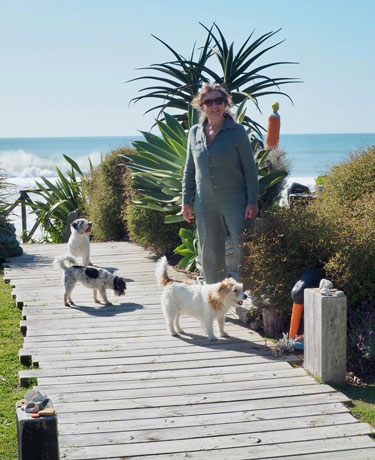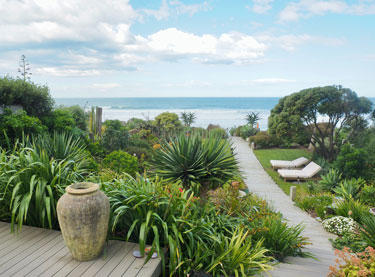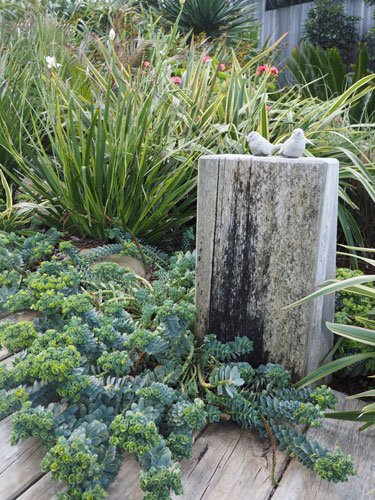Force of nature
Every morning Bronwyn Kay and her three little dogs wake up to the waves rolling in from the Pacific Ocean. The breathtaking view seen through their super-sized windows is part nature, part art. Bronwyn’s striking garden with its wide enticing boardwalk, links her house to the beach below.
As anyone who has ever gardened beach-side will know, the prevailing conditions are more challenging than most. Plants must be able to stand up to wild salt winds and dry impoverished soils. None of this fazes Bronwyn, a successful businesswoman who has been gardening at the edge of the ocean for 40 years.
“I never dreamed of living at the beach, but I came here for love and I’ve never left,” she reveals. A teenage son who loved to surf first inspired Bronwyn to make the move to Gisborne’s Wainui Beach as a newly single young mother of two. As her children grew up in the idyllic location, Bronwyn worked hard to build her real estate business while unleashing her creative energy on a string of seaside gardens. This is her fourth at Wainui Beach.
Her current garden is right next door to her first seaside garden. It was there, while recovering from breast cancer, that she first discovered the restorative powers of garden making. The lofty silhouettes of the cacti she planted all those years ago are now an impressive part of her borrowed landscape.
In her new garden, now three years in the making, a pair of pohutukawa trees brings back fond memories of her old neighbour Nancy who planted them. These are the only trees Bronwyn has kept from the overgrown thicket of trees and shrubs that had completely concealed the sea view by the time she arrived.
Today, where Nancy’s bach once stood, is an elegant piece of modern architecture, which Bronwyn completed in 2020.“At first I planned to keep the original bach but my architect had other ideas,” says Bronwyn. Like Nancy’s bach, the new house sits snuggly and unpretentiously on its site. The little nameplate in the entrance garden reads, ‘The Bach’, but this stunning light-filled home is no ordinary kiwi icon. As you move through the house, each new perspective offers another awe-inspiring scene through garden to sea. The ocean and all its drama is all-pervasive, whether you’re indoors or out.
“I wanted to feel like I was coming home to a resort,” says Bronwyn. With no plans to retire any time soon, she loves her busy working life, and she loves coming home. A boardwalk to the sea has featured in all Bronwyn’s gardens. She surrounds this design signature with her skilfully curated collection of tough coastal plants and garden art. “The boardwalk was the first thing that went down after I cleared the property,” says Bronwyn. Then, long before the house went in, “I was down here early in the morning and late at night, planting and watering my plants.”
Once they’re established, her plants must stand up to whatever nature throws at them.“After four decades gardening here, I’ve come to know what grows best, and what I like,” she says. Although this doesn’t stop her trying new planting ideas. She credits her friend Rob Bayley for his advice; “He told me always create your canopy first. Once you have shelter and shade, you can grow a surprising variety of plants.”
Thick swathes of tough native shrubs filter and slow the salt and sand laden wind as it sweeps up from the beach. Massed plantings of mounding Muehlenbeckia, Corokia and flaxes provide sheltered microclimates for smaller plants without blocking the view, while their earthy colours and textures work beautifully as a foil to colourful sculptures and exotic accent plants.
Plants that wave in the wind, in contrast to the solid forms of structures and succulents, feature strongly in Bronwyn’s planting design. The compact native Phormium ‘Green Dwarf’ with its mass of yellow flowers partners with variegated flax to soften the lines of timber steps and decking.
Other wind dancers include flowering Dietes grandiflora, the tough African iris, Lomandra ‘White Sands’, various Carex grasses, the tough native reed Apodasmia similis (oioi) and pretty perennial Gaura ‘So White’. At the beach end of the garden, informal mounds of shrubby tororaro (Muehlenbeckia astonii) shelter a secluded sitting area. The tight twiggy habit and tiny heart shaped leaves of this coastal native provides the perfect stage for sculptures Gabriel and Gladys, Bronwyn’s ‘Lanky Ladies’ and their mate, ‘Miss Santorini’ by Coromandel artist, Gary Nevin.
Looking as happy as if they’d planted themselves by the stairway down to the beach, the silvery corokias and grassy coastal astelia (Astelia banksii) juxtapose beautifully against the rich russet tones of Muehlenbeckia and flowering oioi. When her daughter was looking for a new home for an orphaned pair of dune aloes (Aloe thraskii), Bronwyn had the perfect spot. They now thrive at the gardens frontier where they stand sentinel. “Their wonderful Dr Seuss shapes make me smile,” she says.
Also looking like something out of a Dr Seuss book, Bronwyn’s tree spurges (Euphorbia lambii) feature further back in the garden. This tough succulent from the Canary Islands forms a rounded tree shape on a clear trunk with showy chartreuse flower bracts in spring.
Bronwyn makes the most of mulch to keep her soil cool and moist. Regular mulching also keeps the job of weeding to a minimum. Apart from a strip of low maintenance lawn either side of the boardwalk, all outdoor surfaces are either paved, decked or planted. There are no vegetable gardens or needy flowers. Bronwyn, who works a lot and loves to travel, has made sure she is no slave to her garden resort by the sea.
COASTAL PLANTING
- Create shelter and shade - plant your canopy first!
- Use rocks to anchor your plants and protect the roots
- Mulch to retain precious moisture.
- Seaweed is ideal as mulch, and in compost.
- Trim in early spring before growth kicks in.
- Plant with compost and slow release fertiliser.
GET THE LOOK: PLANTS FOR SEASIDE GARDENS
Shelter: Corokia, Coprosma repens, Muehlenbeckia astonii, Myoporum (Ngaio), Pittosporum crassifolium (karo), Metrosideros (Pohutukawa), Olearia, Phormium (NZ flax).
Groundover: Euphorbia mysinites, Crassula ovata, Senecio serpens, Echeveria, Pachystegia (Marlborough rock daisy), Coprosma acerosa.
Grassy: Astelia banksii (coastal astelia), Apodasmia similis (oioi), Carex testacea (tussock grass), Chionochloa rubra, Dietes grandiflora, Festuca coxii (blue grass), Lomandra.
Tall accent: Aloe, Agave, Dracaena, Echium fastuosum (Pride of Madeira), Euphorbia, Xeronema (Poor Knights lily).
Colour:
Arctotis, Gazania, Osteospermum (African daisies),
Argyranthemum (Marguerite daisy),
Armeria maritima, Dreameria (sea thrift),
Cistus (Rock rose),
Lampranthus (ice plant),
Pelargonium.

15-Nov-2022

Bronwyn, Benji, Lola and Ewok arrive back from their morning walk.

From every angle, the sea is the star of the scene. Architectural plants frame the views and play with the horizon.

A boardwalk from the sea leads to Nancy's bach.

Artworks by Gary Nevin feature among the Muehlenbeckia around the seafront sitting area.

Euphorbia myrsinites, flax and Dietes

